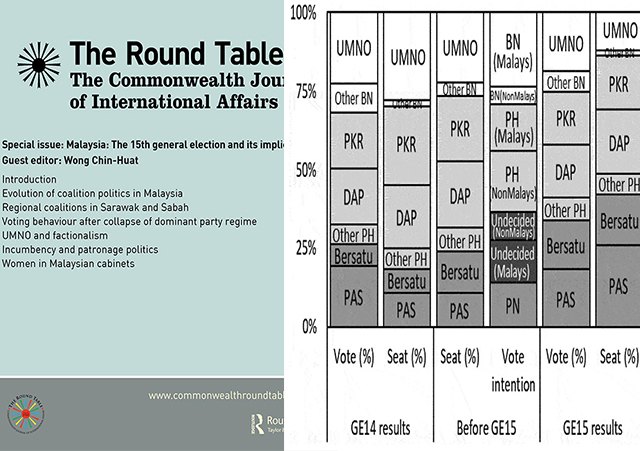 Graph from article shows a comparison of pre-electoral voting intention with actual results of GE14/GE15.
Source: Vote/seat (%) (GE14/15: Election Commission, before GE15: various news reports) and vote intention.
Graph from article shows a comparison of pre-electoral voting intention with actual results of GE14/GE15.
Source: Vote/seat (%) (GE14/15: Election Commission, before GE15: various news reports) and vote intention.
[This is an excerpt from an article in The Round Table; The Commonwealth Journal of International Affairs.]
The result of the post-electoral survey (Survey 3) in Figure 9 also confirms that the lower income voters were 4.6 percentage points more likely to support PN than the higher income voters, who were 10.4 percentage points more likely to support PH than the lower income group (p < .001). This also indicates that the lower income voters turned to PN just before the election, whereas the higher income group remained sided with PH. Although the results are similar when the sample is restricted to Malays, there were some differences.
The findings here support the argument that economic grievances played an important role in the last-minute swing to PN. Given that voting behaviour was strongly associated with ethnicity, further research is needed to discern how economic grievances and ethnic sentiment interacted.
Finally, it is allegedly argued that PN effectively used TikTok in campaigning to garner support from younger voters (e.g., Iman Research, Citation2023; Ooi, Citation2023). Because Surveys 1 and 2 did not contain questions about media usage, this paper applied a multinomial regression model to Survey 3 to assess the association between voting behaviour and the media usage for political information collection. Figure 10 illustrates the marginal effects of media usage on voters’ choices. Although the associations do not necessarily mean causal effects, it shows that TikTok (and WhatsApp) users were 16.4 points (p < .01) more likely to support PN. Voters who relied on newspapers (including those online) were 15.5 points more likely to support PH (p < .001) (and, among Malays, twitter users were 18.9 points more likely to support PH [p < .001]), whereas those who usually watch TV were 9.6 points more likely to choose BN (p < .001). The results imply that parties need to elaborate communication strategies to reach out to different segments of voters.
Malaysia: The 15th general election and its implications – Special edition
Introduction: Hung parliament, coalition government and the rise of the Islamists – Malaysia after the 2022 election
Anwar’s long walk to power: The 2022 Malaysian general elections
Conclusion
The ‘Green Wave’ of GE15 surprised the Malaysian people and observers. Although some have begun to refute the narrative of a ‘Green Wave’, politicians and media still mention it. Given the scarcity of systematic analyses, it is essential to explore the background of PN’s advance in GE15. The electoral results confirmed a clear-cut, ethnic cleavage. However, as this study demonstrates, the wave was mainly caused by the last-minute swing of undecided voters, who were primarily motivated by their economic grievances rather than ethno-religious concerns. Although PN garnered support from younger voters by using its catchy TikTok campaigning, this does not mean that such voters were ideologically wedded to its doctrine. PAS’s vote share in the Peninsula remained less than 20%, and its seat increase was inflated by malapportionment bias. Although some PN supporters (particularly PAS supporters) cared about the ethno-religious cause, others (particularly Bersatu supporters) were motivated by the distributive benefits and the discontent with UMNO. Except in Kelantan and Terengganu, voters may not have even recognised whether their PN candidates were green (PAS) or blue (Bersatu).
The findings here provide some implications for former opposition parties, that assume power after authoritarian party dominance. Because the core supporters of such parties tend to be urban, liberal, high-income voters, promoting political reform is crucially important to sustain the supporting base. Doing so also helps level the playing field that has been distorted by long-term authoritarian party dominance. Yet, catering to the demands of non-partisan, swing voters is equally as important as holding the supporting base. As this paper reveals, the major concerns of undecided voters were bread-and-butter issues. Therefore, the new government needs to alleviate their economic grievances. Promoting a series of democratic reforms is compatible with economic programmes for them. It has become relatively easy to obtain BN’s cooperation in proceeding with some of political reform issues. For instance, fixing the malapportionment bias by reducing the intra-state imbalances is now a more feasible option. PH can also expect cooperation from PN in some reform agendas, such as the equal distribution of Constituency Development Funds for individual MPs.
If the malapportionment bias continues to benefit PAS, a ‘Green Wave’ will remain as a de facto reality. That bias may enable PAS to promote Islamisation issues and capitalise on seat leverage at the time of coalitional realignment. Yet, one should not be ensnared by the narrative of a ‘Green Wave’. Shifting to a Malay-centric stance to counter the ‘greenish’ blue wave or wooing non-Malay support with a fearmongering ‘green tsunami’ both entail the risk of deepening the cleavage. Focusing on people’s economic grievances and reaching out to young voters by way of effective communication strategies help prevent the deepening of the ethno-religious polarisation. If the Anwar government fails, non-partisan voters will be susceptible to ethno-religious mobilisation, and the ‘blue wave’ can turn to green. The future trajectory of Malaysian politics depends on the Anwar government and the choice of (particularly unaligned) Malaysian voters.
Hidekuni Washida is with the Faculty of Law, Toyo University, Tokyo, Japan.



